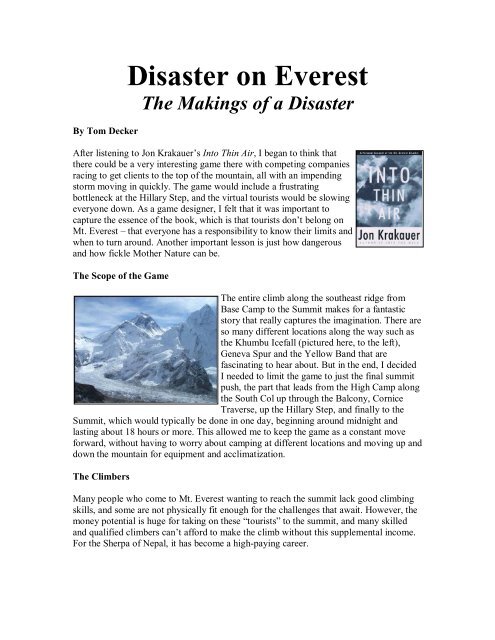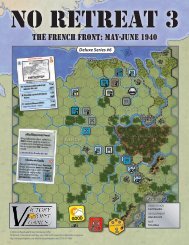Making of Disaster on Everest - Victory Point Games
Making of Disaster on Everest - Victory Point Games
Making of Disaster on Everest - Victory Point Games
You also want an ePaper? Increase the reach of your titles
YUMPU automatically turns print PDFs into web optimized ePapers that Google loves.
By Tom Decker<br />
<str<strong>on</strong>g>Disaster</str<strong>on</strong>g> <strong>on</strong> <strong>Everest</strong><br />
The <str<strong>on</strong>g>Making</str<strong>on</strong>g>s <str<strong>on</strong>g>of</str<strong>on</strong>g> a <str<strong>on</strong>g>Disaster</str<strong>on</strong>g><br />
After listening to J<strong>on</strong> Krakauer’s Into Thin Air, I began to think that<br />
there could be a very interesting game there with competing companies<br />
racing to get clients to the top <str<strong>on</strong>g>of</str<strong>on</strong>g> the mountain, all with an impending<br />
storm moving in quickly. The game would include a frustrating<br />
bottleneck at the Hillary Step, and the virtual tourists would be slowing<br />
every<strong>on</strong>e down. As a game designer, I felt that it was important to<br />
capture the essence <str<strong>on</strong>g>of</str<strong>on</strong>g> the book, which is that tourists d<strong>on</strong>’t bel<strong>on</strong>g <strong>on</strong><br />
Mt. <strong>Everest</strong> – that every<strong>on</strong>e has a resp<strong>on</strong>sibility to know their limits and<br />
when to turn around. Another important less<strong>on</strong> is just how dangerous<br />
and how fickle Mother Nature can be.<br />
The Scope <str<strong>on</strong>g>of</str<strong>on</strong>g> the Game<br />
The entire climb al<strong>on</strong>g the southeast ridge from<br />
Base Camp to the Summit makes for a fantastic<br />
story that really captures the imaginati<strong>on</strong>. There are<br />
so many different locati<strong>on</strong>s al<strong>on</strong>g the way such as<br />
the Khumbu Icefall (pictured here, to the left),<br />
Geneva Spur and the Yellow Band that are<br />
fascinating to hear about. But in the end, I decided<br />
I needed to limit the game to just the final summit<br />
push, the part that leads from the High Camp al<strong>on</strong>g<br />
the South Col up through the Balc<strong>on</strong>y, Cornice<br />
Traverse, up the Hillary Step, and finally to the<br />
Summit, which would typically be d<strong>on</strong>e in <strong>on</strong>e day, beginning around midnight and<br />
lasting about 18 hours or more. This allowed me to keep the game as a c<strong>on</strong>stant move<br />
forward, without having to worry about camping at different locati<strong>on</strong>s and moving up and<br />
down the mountain for equipment and acclimatizati<strong>on</strong>.<br />
The Climbers<br />
Many people who come to Mt. <strong>Everest</strong> wanting to reach the summit lack good climbing<br />
skills, and some are not physically fit enough for the challenges that await. However, the<br />
m<strong>on</strong>ey potential is huge for taking <strong>on</strong> these “tourists” to the summit, and many skilled<br />
and qualified climbers can’t afford to make the climb without this supplemental income.<br />
For the Sherpa <str<strong>on</strong>g>of</str<strong>on</strong>g> Nepal, it has become a high-paying career.
So, in the game, players take the roles <str<strong>on</strong>g>of</str<strong>on</strong>g> these “travel companies” who hire skilled<br />
climbers to assist their high-paying clients seeking to reach the Top <str<strong>on</strong>g>of</str<strong>on</strong>g> the World. Clients<br />
and guides use their movement points, but to add to the planning and strategy, not<br />
every<strong>on</strong>e can move each a turn. Additi<strong>on</strong>ally, clients have traits that can aid or hinder<br />
their climb, while guides have a variety <str<strong>on</strong>g>of</str<strong>on</strong>g> useful skills. These traits and skills add to the<br />
pers<strong>on</strong>ality <str<strong>on</strong>g>of</str<strong>on</strong>g> the game, creating more strategic opti<strong>on</strong>s and fascinating decisi<strong>on</strong>s for the<br />
players. With these variables, the gameplay is different every time, even if you try the<br />
same methods.<br />
The Hillary Step<br />
The first mechanic I tackled was how to<br />
handle the Hillary Step. The Step is a rock<br />
wall that is the <strong>on</strong>e technical porti<strong>on</strong> <str<strong>on</strong>g>of</str<strong>on</strong>g> the<br />
climb. Traditi<strong>on</strong>ally, Sherpa or other<br />
expert climbers scale the wall first, setting<br />
ropes for the others to use as they follow.<br />
While it’s not literally a queue or<br />
completely random, I thought that<br />
injecting a die roll here and making it a<br />
literal queue in the game would help<br />
capture that feeling <str<strong>on</strong>g>of</str<strong>on</strong>g> frustrati<strong>on</strong> <str<strong>on</strong>g>of</str<strong>on</strong>g> being<br />
caught behind slower moving people.<br />
There is randomness to it, and yet you can<br />
c<strong>on</strong>trol things a bit by deciding when to<br />
put people into the queue and in what<br />
order. Going up and down the Hillary Step<br />
is ultimately handled in a very different<br />
way than moving <strong>on</strong> the rest <str<strong>on</strong>g>of</str<strong>on</strong>g> the<br />
mountain.
The Impending Storm<br />
The sec<strong>on</strong>d mechanic I needed to come up with was<br />
how to handle the storm. For the purposes <str<strong>on</strong>g>of</str<strong>on</strong>g> this<br />
game, the storm IS going to come. But like in the<br />
movie War <strong>Games</strong>, the <strong>on</strong>ly real soluti<strong>on</strong> to the game<br />
is not to play at all. Every<strong>on</strong>e should stay back at<br />
High Camp or run screaming down the mountain, but<br />
that wouldn’t make much <str<strong>on</strong>g>of</str<strong>on</strong>g> a game. So we assume<br />
that not <strong>on</strong>ly is the temptati<strong>on</strong> <str<strong>on</strong>g>of</str<strong>on</strong>g> wealth and fame<br />
pushing you to send people out <strong>on</strong> this fateful day,<br />
but that perhaps you really d<strong>on</strong>’t know what’s coming, and you’re certainly not going to<br />
disappoint these high-paying clients. Thus, the c<strong>on</strong>flict is writ large between people and<br />
the envir<strong>on</strong>ment.<br />
So the mechanic <str<strong>on</strong>g>of</str<strong>on</strong>g> spending prestige and thus<br />
“selling your soul” to delay the storm, therefore<br />
exposing your guides and tourists to<br />
experiencing Events (both good and bad) felt<br />
like the right mechanic to capture this feeling<br />
<str<strong>on</strong>g>of</str<strong>on</strong>g> the impending disaster. As added incentive,<br />
the points earned are high for getting clients to<br />
the summit, and there are substantial penalties<br />
if they do not at least reach the Hillary Step. In<br />
the beginning, it all seems easy and players<br />
think that they’re going to get every<strong>on</strong>e up and<br />
down. But right around the Summit, they start to realize that there’s no way to get<br />
every<strong>on</strong>e down the mountain in time. That is the feeling I wanted to capture: an “Oh,<br />
crud! How are we going to get out <str<strong>on</strong>g>of</str<strong>on</strong>g> this mess!?” sense <str<strong>on</strong>g>of</str<strong>on</strong>g> doing your best in an<br />
increasingly desperate situati<strong>on</strong>.<br />
The Events<br />
As in real mountain climbing, fate might supply good and bad events al<strong>on</strong>g the<br />
way. You’ll have c<strong>on</strong>trol over some <str<strong>on</strong>g>of</str<strong>on</strong>g> them, while others are simply forced up<strong>on</strong><br />
you. Each event adds to the story narrative, lending verisimilitude to<br />
the gameplay experience, and thus your team may narrowly avoid an<br />
avalanche or be slowed by a particularly icy ridge.<br />
The blocked ridges in the game represent places where things slow<br />
down because there are so many people <strong>on</strong> the mountain. These are actual<br />
occurrences when too many people try to summit <strong>on</strong> the same day. Blocked<br />
ridges can also represent where new ropes need to be laid to help guide the less<br />
skilled clients. In any case, they are frustrating bottlenecks that happen <strong>on</strong><br />
<strong>Everest</strong>, and therefore happen in the game as well. Success in navigating around these<br />
blocked ridges <str<strong>on</strong>g>of</str<strong>on</strong>g>ten plays a large role in determining your overall victory.
Pers<strong>on</strong>ality<br />
Finally, it was important to me that, after you completed a<br />
game <str<strong>on</strong>g>of</str<strong>on</strong>g> <str<strong>on</strong>g>Disaster</str<strong>on</strong>g> <strong>on</strong> <strong>Everest</strong>, you could recall a great story<br />
from the experience, whether your score was good or bad.<br />
While I ultimately reduced the amount <str<strong>on</strong>g>of</str<strong>on</strong>g> informati<strong>on</strong> and<br />
pictures <str<strong>on</strong>g>of</str<strong>on</strong>g> guides and clients in the game, there is still enough<br />
to be able to create real and interesting characters and<br />
situati<strong>on</strong>s in the player’s mind. There should be enough there<br />
so that players feel an emoti<strong>on</strong>al resp<strong>on</strong>se to leaving some<strong>on</strong>e<br />
up high <strong>on</strong> the mountain or risking some<strong>on</strong>e getting lost<br />
coming <str<strong>on</strong>g>of</str<strong>on</strong>g>f a ridge al<strong>on</strong>e.<br />
<strong>Victory</strong><br />
I wanted to come up with a different method, other than luck<br />
<str<strong>on</strong>g>of</str<strong>on</strong>g> the draw, to determine each character’s ultimate fate when<br />
exposed to the storm, but in the end I felt it truly does come<br />
down to the luck <str<strong>on</strong>g>of</str<strong>on</strong>g> the draw, so why not simulate it as such?<br />
Of course, during gameplay, players are given some c<strong>on</strong>trol<br />
<str<strong>on</strong>g>of</str<strong>on</strong>g> the luck element with their use <str<strong>on</strong>g>of</str<strong>on</strong>g> equipment, planning,<br />
and putting the right people together, but having the final<br />
destiny <str<strong>on</strong>g>of</str<strong>on</strong>g> those exposed at the end just felt right. In real<br />
situati<strong>on</strong>s, <str<strong>on</strong>g>of</str<strong>on</strong>g>ten who lives and who dies in these disasters<br />
doesn’t make a lot <str<strong>on</strong>g>of</str<strong>on</strong>g> sense.<br />
In the early versi<strong>on</strong>s <str<strong>on</strong>g>of</str<strong>on</strong>g> <str<strong>on</strong>g>Disaster</str<strong>on</strong>g> <strong>on</strong> <strong>Everest</strong>, balancing the victory c<strong>on</strong>diti<strong>on</strong>s was very<br />
difficult. Only after much playtesting did the current method evolve. There needed to be a<br />
balance between earning points for climbing higher <strong>on</strong> the mountain, while receiving<br />
penalties for losing clients al<strong>on</strong>g the way. As menti<strong>on</strong>ed earlier, the <strong>on</strong>ly real victory<br />
would be for every<strong>on</strong>e to survive, but for the purposes <str<strong>on</strong>g>of</str<strong>on</strong>g> the game, survival plus<br />
reaching the summit is better than merely surviving.<br />
C<strong>on</strong>clusi<strong>on</strong><br />
I love the thought <str<strong>on</strong>g>of</str<strong>on</strong>g> climbing Mt. <strong>Everest</strong> and standing “<strong>on</strong> top <str<strong>on</strong>g>of</str<strong>on</strong>g> the world!” But the<br />
reality is that humans were not meant to survive about 8,000 meters, and I certainly know<br />
that it’s not something I’m ever going to achieve. And while there are some skilled and<br />
experienced climbers who can handle the challenges, it really shouldn’t be a place for<br />
“tourists.” The book Into Thin Air does an great job covering this topic, detailing some <str<strong>on</strong>g>of</str<strong>on</strong>g><br />
the amazing heroes who risked their lives for others, and some who just had an incredible<br />
will to survive. Hopefully, as you play the game, you will find some heroes and create<br />
some great stories al<strong>on</strong>g the way. And if your game goes particularly poorly, you will<br />
experience your own <str<strong>on</strong>g>Disaster</str<strong>on</strong>g> <strong>on</strong> <strong>Everest</strong>.
















